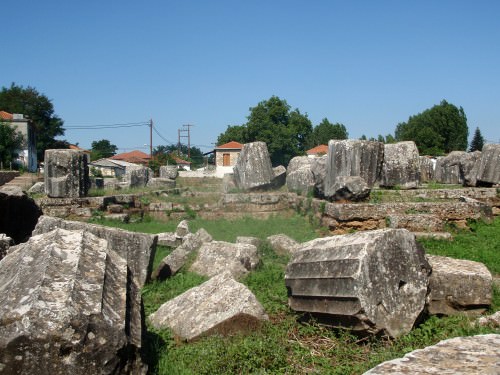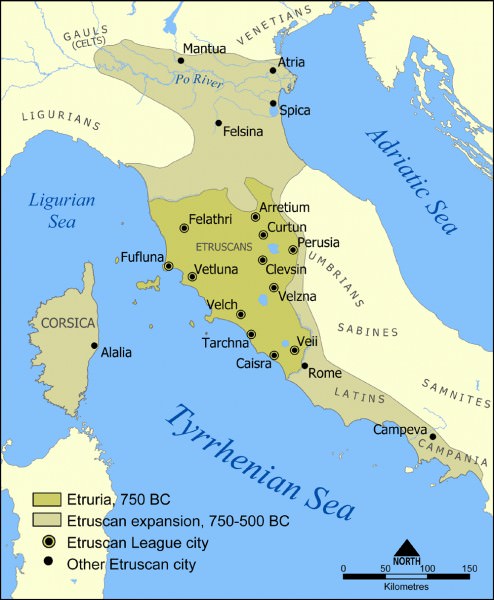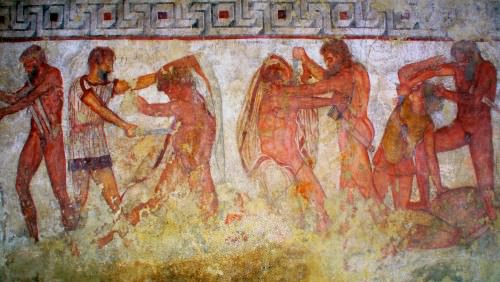Tegea › Vulci » Ancient origins
Articles and Definitions › Contents
- Tegea › Ancient History
- Vulci › Ancient History
Ancient civilizations › Historical and archaeological sites
Tegea › Ancient History
Definition and Origins

Tegea was an ancient Greek city-state or polis in the southeast of Arcadia in the Peloponnese. The city participated in wider Greek affairs such as the Persian Wars of the early 5th century BCE and was a valuable ally of Sparta during the Peloponnesian War at the other end of the same century. The city was the site of an important sanctuary to the goddess Athena Alea, which had a large 4th century BCE Doric temple.
EARLY SETTLEMENT
In mythology, the town was founded by Tegeates (son of Lycaon, the king of Arcadia) or Aleus (another legendary Arcadian king). The archaeological record shows that Tegea was first settled in the Neolithic period and was an important Mycenaean site. The latter period has left remains of tholos tombs (at Analipsi) and a dike (Lake Takka). Homer lists Tegea in his Iliad as one of the poleis which supplied ships in the Trojan War. From the Archaic period, or even earlier, Tegea was an important cult site to the goddess Alea, who had her own athletic games – the Alaiea – and who later became identified with Athena.
A SPARTAN ALLY
When the Spartans became more ambitious in the Peloponnese in the mid-6th century BCE, Tegea was forced to become their ally. Herodotus described Tegea's successful resistance to Spartan expansion in the early 6th century BCE, but the two cities did sign a treaty of mutual agreement, which laid the foundation for the Peloponnesian League (c. 550 BCE - c. 366 BCE). In wider Greek politics Tegea sent hoplites to fight alongside other Greek states in the battles of Thermopylae (480 BCE) and Plataea (479 BCE) against the invading Persian army of Xerxes. After victory at the latter, Herodotus informs us ( Histories, 9.70) that the Tegeans took the magnificent bronze horse trough of the Persian general Mardonius and dedicated it in their temple back home.
THE 4TH-CENTURY BCE TEMPLE WAS CONSTRUCTED IN MARBLE & WAS ONLY SLIGHTLY SMALLER THAN THE GREAT TEMPLE OF ZEUS AT OLYMPIA.
In the Classical period, Tegea controlled a large territory, some 385 km² separated into nine demes, which included land suitable for agriculture, grazing, and a marble quarry at Doliana. The town's location was also an advantage, situated as it was on routes leading to Argos and Sparta. Tegea spread to cover 190 ha and also minted its own coinage. Remains of a 5th-century BCE wall show that Tegea was encircled by fortifications which included five gates and several towers. The town itself was laid out in a grid pattern.
There were several attempts by Tegea to break from their powerful neighbour Sparta's grasp, notably a spirited resistance but ultimate defeat at the battle of Dipaea in 470 BCE. Thereafter, Tegea remained a loyal ally of Sparta, including during the Peloponnesian War (431 - 404 BCE). However, when Sparta was defeated by Thebes at the Battle of Leuctra in 371 BCE, Tegea sought more political freedom of action in the new Greek world. The city formed a federal Arcadian state, the Arcadian League, alongside long-time local rival Mantinea in 370-369 BCE, with its capital at Megalopolis.

Temple of Athena Alea, Tegea
THE SANCTUARY OF ATHENA ALEA
The sanctuary to Athena Poliatis is mentioned in the writings of the ancient travel writer Pausanias, but its remains are yet to be discovered. This sanctuary may have stood on a low hill north of the town proper. There are remains, though, of the sanctuary to Athena Alea. Located outside the city walls the sanctuary was dominated by a 4th-century BCE Doric temple dedicated to the goddess. The sanctuary site shows evidence of cult worship dating back to the 10th century BCE as indicated by the presence of votive offerings. Following the construction of modest wattle-and-daub buildings in the sanctuary's early stages, a first stone temple was built in the 7th century BCE. This structure had 6 x 18 columns but was destroyed by a fire c.395 BCE.
The replacement 4th-century BCE temple was designed by the famous sculptor and architect Skopas from Paros (active 370 – 330 BCE). The temple was constructed in marble and presented six columns on each facade and 14 along the long sides. It measured 47 x 22 metres, making it only slightly smaller than the great temple of Zeus at Olympia. The temple was an innovative design with Skopas engaging the interior columns into the cella walls and mixing orders by having the bases of the columns in Corinthian order and the top ones Ionic. Inside the temple once stood a large ivory statue of Athena Alea and several less important statues including ones of Asclepius and Hygeia, indicative of the sanctuary's reputation for healing.Some fragments of decorative sculpture survive suggesting the pediments carried scenes from Greek mythology, including the battle between Achilles and Telephos, and the Calydonian boar-hunt led by Meleager. According to tradition, the temple actually contained the hide of this legendary animal.

Persephone, Demeter, & Pluto Marble Plaque, Tegea.
HELLENISTIC & ROMAN PERIODS
The town continued to prosper into the Hellenistic period as evidenced by the life of one of Tegea's famous residents, the poetess Anyte of Tegea, and the remains of a 2nd-century BCE theatre excavated at the site. This theatre was itself a replacement of an earlier one and was funded by Antiochus IV Epiphanes in 175 BCE. Parts of the older theatre can be seen today in the foundations of the church of the Panayia while the second theatre had an early Christian church built on its cavea.
Tegea, along with many other Greek cities, was controlled by Rome from 146 BCE. Later in the Roman period Tegea supported Mark Anthony, but following his defeat at the Battle of Actium in 31 BCE Tegea's disloyalty to Augustus resulted in many of the city's prized artworks being removed to Rome. Not enjoying any particular prominence in the centuries thereafter, Tegea suffered destruction at the hands of the invading Visigoths in 395 CE. The town did recover somewhat to become the seat of a bishop from the 5th century CE, and remains of churches and a basilica of that period can be seen at the site today, which include several fine mosaics. Eventually, Tegea was abandoned and covered in silt deposits from the Alpheios River (modern Sarantapotamos).
Vulci › Ancient History
Definition and Origins

Vulci (Velch) was an Etruscan city located 12 km from the western coast of central Italy by the banks of the Fiora River.Flourishing as a trading port between the 6th and 4th century BCE, it was an important member of the Etruscan League. The archaeological site has yielded many bronze works and a vast quantity of fine pottery, which has filled museums worldwide, but its most impressive contribution to our knowledge of the Etruscans is the many tombs at the site, including the 4th-century BCE Francois Tomb with its vibrant wall paintings.
EARLY SETTLEMENT & GEOGRAPHY
There are few written sources describing the history of Vulci, known as Velch to the Etruscans themselves, but substantial archaeological remains are testimony to its prosperity from the 6th to 4th century BCE. The site had been inhabited since the Neolithic period but was long overshadowed by nearby Tarquinii in the first centuries of the 1st millennium BCE. The wealth of the city was based on three factors: fertile agricultural lands, rich metal deposits in nearby Monte Amiata, and its strategic location on the Fiora River, allowing it to control trade from the coast to inland territories. The city's seaport has been identified by some scholars as Regae.
VULCI DID NOT JUST PROSPER AS A TRADE CENTRE PASSING ON GOODS MADE BY OTHERS BUT WAS ALSO A MAJOR MANUFACTURING CENTRE IN ITS OWN RIGHT.
A THRIVING ETRUSCAN CITY
Vulci did not just prosper as a trade centre passing on goods made by others (especially black-figure and red-figure potteryfrom Greece – often specifically made for the Etruscan market – and faience flasks from Egypt ) but was also a major manufacturing centre in its own right. Fine decorated pottery, the bucchero wares with shiny dark grey surface, bronze work (especially utensils, tripods, braziers, and even chariots), gold jewellery, carved precious stones, wooden boxes inlaid with ivory plaques, bone and ivory spoons, ostrich eggs (imported and then painted by Etruscan artists), and large-scale stone carvings were all produced here. The latter were carved from the local volcanic stone known as nenfro in Vulci's school of stonemasons which influenced other Etruscan cities.
All of these goods were exported throughout Italy and beyond, with Vulci-manufactured wares turning up in tombs across Europe. The high quality of the pottery finds, such items as finely-worked gold jewellery, and the sumptuous adornments and clothes of women depicted in tomb wall paintings all indicate the wealth of Vulci's elite. Further, the general prosperity and cultural pull of the city is illustrated by the presence of such foreign artists as the East Greek 'Swallow Painter,' who set up shop in Vulci and produced there his famous black-figure vases.

Etruscan Civilization
Vulci was one of the twelve (or 15) members of the Etruscan League, a loose association of politically independent cities bound together by common religious ties. The other members included Cerveteri, Chiusi, Populonia, Tarquinia, and Volterra, but their exact relationship is not clear. Ancient authors group them together as Etruria or 'the peoples of Etruria,' and the Roman historian Livy describes an annual meeting of city leaders at the Fanum Voltumnae sanctuary near Orvieto.The inability of the Etruscans to form a cohesive political alliance would be an important factor in their downfall at the hands of their aggressive southern neighbours, the Romans.
The city declined along with the Etruscan civilization in general between 450 and 350 BCE when Syracuse gained control of local shipping routes. Nevertheless, the city did recover somewhat, as attested by such artefacts as marble sarcophagi dating to the second half of the 4th century BCE. However, the revival was to be short-lived as the Romans, led by T. Coruncanius, conquered Vulci in 280 BCE. In 273 BCE a Roman colony was founded at Cosa which took over the lucrative trade routes and condemned Vulci first to be made only a municipium in 90 BCE and then eventual obscurity in the following centuries, a situation not helped by the presence of malaria in the region.
ARCHAEOLOGICAL REMAINS
The site of Vulci today largely contains remains dating from the 4th century BCE, and so there are very few traces of the structures from Vulci's Etruscan heyday. These include portions of the city walls and a large temple platform which measures 24.6 mx 36.4 m. It once had four columns on the short sides and six along the long sides and was perhaps dedicated to Minerva. There are also the remains of several pottery workshops. A cemetery or necropolis has been an incredibly rich source of finds. These and its large size are indicative of the city's wealth in the Archaic period. Objects excavated include stone funerary sculptures, fine decorated pottery vases – both locally made and imports, – gold jewellery pieces, engraved bronze mirrors, a bronze urn in the form of a hut, and a fine 6th-century BCE bronze tripod with lion's claw feet and figures of satyrs, Hercules and Iole.

Attic Black-figure Plate, Vulci
The site has also provided two particularly fine 4th-century BCE marble sarcophagi. Each has a tenderly embracing couple carved on the lid while one has scenes of the husband and wife departing in a chariot for the underworld at either end and the second has scenes involving Amazons. Both these coffins are today in the Boston Museum of Fine Arts while many of the finest small-scale Etruscan art pieces are to be found in the Museo Etrsuco di Villa Giulia in Rome.
THE TOMBS OF VULCI
The larger tombs at Vulci were guarded by stone sculptures of Greek monsters such as centaurs, sphinxes, rams and winged lions, but it is their interiors which are of special interest. The 6th-century BCE tomb of ' Isis ' was excavated by Napoleon's brother Lucien Bonaparte in 1839 CE, and it contained many fine artworks (now mostly at the British Museum). These include a hammered bronze bust of an unidentified goddess holding a horned bird, an 89 cm tall statuette of a standing woman, and a stamped gold sheet diadem. Another tomb, the Tomb of the Bronze Chariot, contained a 7th-century BCE embossed sheet bronze chariot.

Battle Scene, Francois Tomb, Vulci
The Tomb of the Warrior dates to around 510 BCE and is so-called because of the bronze armour and weapons found therein.There was a large bronze shield, a Negau-type helmet decorated with images of the river god Achelos and a crest holder shaped in the form of the Dioscuri, greaves (shin protectors), a bronze sword with iron scabbard, and two spears. In addition, there was an entire banqueting set of bronze vessels and utensils – evidence of the Etruscan custom where leaders offered their followers free banquets as a symbol of their power and status.
Most spectacular of all the tombs is the late 4th-century BCE Francois Tomb with its painted walls, showing lively scenes from Greek and Etruscan mythology, various battle scenes with the Romans, and the Vulci rulers fighting against those of the rival Etruscan towns of Volsinii and Sovana. There are funeral games where prisoners are sacrificed in gladiator matches, and one fresco shows a man named in an inscription as Vel Saties, perhaps the occupant of the tomb. The figure, possibly a magistrate, wears a dark blue embroidered cloak and is accompanied by a dwarf holding a woodpecker attached to a string.The bird is about to be released and Vel Saties looks on, perhaps as he is about to follow it in a metaphor for his passage into the next life.
MAP
LICENSE:
Article based on information obtained from these sources:with permission from the Website Ancient History Encyclopedia
Content is available under License Creative Commons: Attribution-NonCommercial-ShareAlike 3.0 Unported. CC-BY-NC-SA License